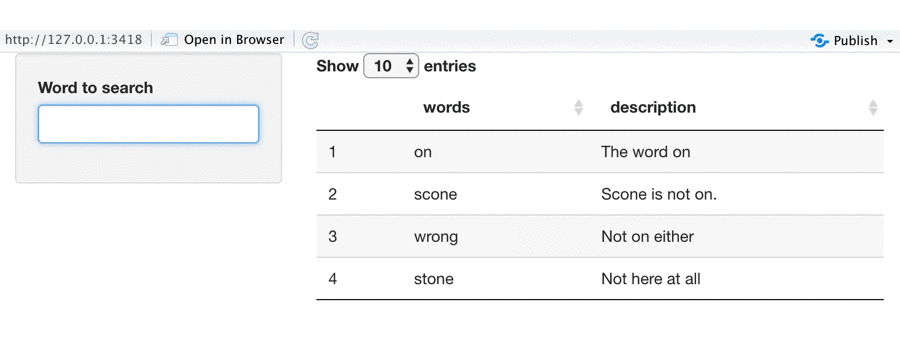基于正则表达式高亮显示DT中的单词
使用DT闪亮,我希望能够突出显示所选单词。设置searchHighlight = TRUE接近我想要的设置,但这也会突出显示包含搜索的单词。例如,如果我要搜索“ on”,它也会与“ stone”匹配,突出显示中间的“ on”。
示例图像:
我可以优化搜索选项,使regex = TRUE不变,但是不会突出显示。例如,如果我想使用“ on | in”之类的正则表达式,也是如此。
示例(包括正则表达式):
library(shiny)
library(DT)
library(data.table)
example_data <- data.table(words = c("on", "scone", "wrong", "stone"),
description = c("The word on", "Scone is not on.", "Not on either", "Not here at all"))
ui = shinyUI(fluidPage(
sidebarLayout(
sidebarPanel(
textInput("word_select", label = "Word to search")
),
mainPanel(
dataTableOutput("word_searched")
)
)
))
server = shinyServer(function(input, output, session) {
output$word_searched <- renderDataTable({
datatable(
example_data,
options = list(searchHighlight = TRUE,
search = list(regex = TRUE,
search = paste0("\\b", tolower(input$word_select), "\\b")))
)
})
})
shinyApp(ui = ui, server = server)
DT已通过反应性表达式过滤在单词上,因此所有字段必定会包含所选单词,但我只是想避免引起用户误以为更长的单词被错误地包含在搜索中的困惑。我没有在示例中执行此操作,但只是确认这不是我关注的元素。
感谢您的帮助。
(已编辑,在示例数据中添加了带有标点符号的单词示例。)
2 个答案:
答案 0 :(得分:1)
您可以创建一个reactive元素,而不是依靠数据表的搜索功能,该元素首先按输入进行过滤,然后将匹配的单词替换为嵌入在<span style="background-color:yellow;">标记中的相同单词。这样可以通过更复杂的正则表达式提供更大的搜索灵活性。
您需要将escape = F添加到datatable,以便正确解释HTML标记。我已将options = list(dom = "lt")添加到datatable中,以删除数据表的搜索字段,并将注意力集中在左侧的搜索字段上。
使过滤条件保持相当模糊的状态,以防止表消失,直到找到完美的匹配为止-也就是说,当您键入“ o”时,表不应消失,因为没有完美的匹配,然后在出现“ on”时重新出现。然后,只有找到匹配的单词(即on,On和on.,而不是stone,scone等时,高亮才会出现。一窥它的外观:
这是代码。请注意,我使用dplyr的过滤和变异函数是因为它们可以通过其*_all变体轻松地应用于多个列:
library(shiny)
library(DT)
library(data.table)
library(dplyr) # For `filter_all` and `mutate_all`.
example_data <- iris
# data.table(words = c("on", "scone", "wrong", "stone"),
# description = c("The word on", "Scone is not on.", "Not on either", "Not here at all"))
ui = shinyUI(fluidPage(
sidebarLayout(
sidebarPanel(
textInput("word_select", label = "Word to search")
),
mainPanel(
dataTableOutput("word_searched")
)
)
))
server = shinyServer(function(input, output, session) {
# This is your reactive element.
df_reactive <- reactive({
example_data %>%
# Filter if input is anywhere, even in other words.
filter_all(any_vars(grepl(input$word_select, ., T, T))) %>%
# Replace complete words with same in HTML.
mutate_all(~ gsub(
paste(c("\\b(", input$word_select, ")\\b"), collapse = ""),
"<span style='background-color:yellow;'>\\1</span>",
.,
TRUE,
TRUE
)
)
})
# Render your reactive element here.
output$word_searched <- renderDataTable({
datatable(df_reactive(), escape = F, options = list(dom = "lt"))
})
})
shinyApp(ui = ui, server = server)
答案 1 :(得分:0)
我不确定这是否是您真正想要的,但是我认为这很接近:这不会执行精确的搜索(例如,“ on”将匹配“ stone”),但是这只会突出显示完全匹配< / em>(例如,“ on”将不会突出显示)。这将使用mark.js库。
dtable <- datatable(iris[c(1,2,51,52,101,102),],
options = list(
mark = list(accuracy = "exactly")
)
)
dep1 <- htmltools::htmlDependency(
"datatables.mark", "2.0.1",
src = c(href = "https://cdn.datatables.net/plug-ins/1.10.19/features/mark.js"),
script = "datatables.mark.min.js")
dep2 <- htmltools::htmlDependency(
"jquery.mark", "8.11.1",
src = c(href = "https://cdnjs.cloudflare.com/ajax/libs/mark.js/8.11.1"),
script = "jquery.mark.min.js")
dtable$dependencies <- c(dtable$dependencies, list(dep1, dep2))
dtable
- 我写了这段代码,但我无法理解我的错误
- 我无法从一个代码实例的列表中删除 None 值,但我可以在另一个实例中。为什么它适用于一个细分市场而不适用于另一个细分市场?
- 是否有可能使 loadstring 不可能等于打印?卢阿
- java中的random.expovariate()
- Appscript 通过会议在 Google 日历中发送电子邮件和创建活动
- 为什么我的 Onclick 箭头功能在 React 中不起作用?
- 在此代码中是否有使用“this”的替代方法?
- 在 SQL Server 和 PostgreSQL 上查询,我如何从第一个表获得第二个表的可视化
- 每千个数字得到
- 更新了城市边界 KML 文件的来源?

